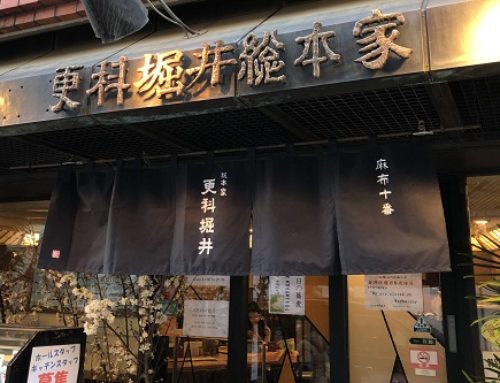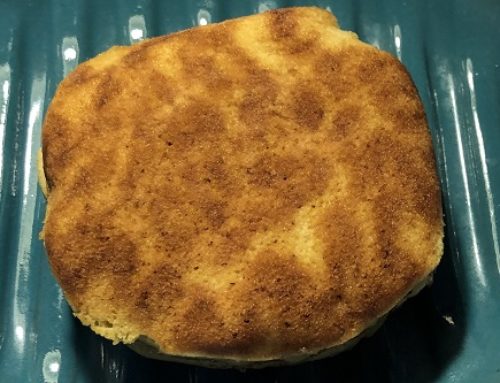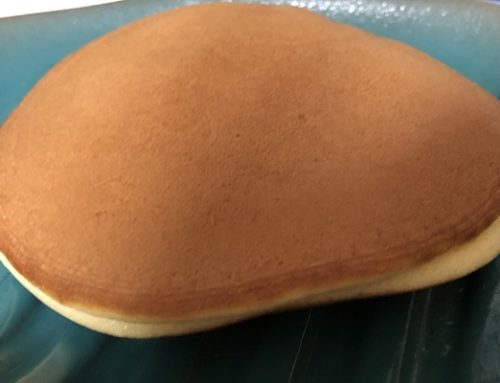Not all Wagashi (Japanese sweets or confectioneries) are sweet. For example, most senbei (or spelled sembei: Japanese rice crackers) are not sweet. Ordinary they are coated with soy sauce and grilled. Yaki-dango (toasted dumplings) are also flavored with soy sauce. Accordingly I think sweets or confectioneries are not proper words for Wagashi. So, I’d like to use the word “wagashi” hereafter. I introduce you several wagashi that you could buy at Asakusa.
Though there is the very famous wagashi store “Kamejū” at Asakusa, I write it in another post. Refer to the post on Kamejū.
Imo yōkan and Ankodama at Funawa confectionery store
Though Funawa sells various wagashi, Funawa is famous for its Imo yōkan and Ankodama. Imo means potato and yōkan is a certain type of wagashi. Imo yokan’s main ingredient is sweet potato.
To make Imo yōkan, Confectioner steams sweet potatoes, then add sugar while they are still hot, and knead them. Then confectioner pours them into a rectangular parallelepiped mold, and solidify them by cooling. When we eat Imo yōkan, we slice it into suitable size for eating.
Ankodama is a small ball made of anko. Anko is sweet paste made from various beans. Anko made from Azuki (adzuki beans or red beans) is most popular. “Dama” in “Ankodama” means a ball. Ankodama is coated with kanten (made from certain seaweeds and it resembles agar).

Imoyōkan and ankodama
In above picture, two pieces of sliced yellowish parallelepiped are Imo yōkan and a glossy dark brown ball above Imo yōkan is Ankodama. This Ankodama is made from azuki (adzuki beans or red beans). There are other Ankodama in different colors made from other ingredients.
Invention of Imo yōkan
The founder of Funawa store, Wasuke Kobayashi, and wagashi artisan, Sadakichi Ishikawa invented Imo yōkan instead of Neri Yōkan around 1902. Around that time, Neri Yōkan (made from azuki) was very expensive and hard for ordinal people to buy. They wanted to make yōkan that ordinal people could buy easily. They used sweet potato as ingredient and succeeded in making Imo yōkan.
Try Imo yōkan at Funawa’s café
As a bar of Imo yōkan is too large for a person or two, I think it is not advisable to purchase without knowing the taste of Imo yōkan. You can try two pieces of sliced Imo yōkan and other sweets at the café on the second floor of Funawa’s main store. Though Funawa has several stores at Asakusa, only the main store has the café.
The main store is located on the corner of Shin-nakamise-dōri and Orange-dōri (1-22-10 Asakusa, Taitō-ku). Here “dōri” means street.

The main sore of Funawa
The café has a menu with pictures. It opens 10:30 – 19:00 (weekdays), 10:00 – 20:00 (Sat.), 10:00 – 19:30 Sun. & holidays).

Sweets at Funawa café
On left side of above picture, there is Anmitsu. And the dark liquid in the cup above the spoon is mitsu (syrup) for Anmitsu.
Imo yōkan tastes just like sweet potato itself. Some may like this taste. Its ingredients are sweet potatoes, sugar, and salt. As it doesn’t contain any artificial preservatives, you must eat within about 4 days from the date of purchase.
Ankodama is too sweet for me but some may love that sweetness. Ankodama can also eat about 4 days from the date of purchase.
Nakamise-dōri and Azuma store
Nakamise-dōri is the shopping street in front of Sensō-ji (here “ji” means temple). It lies between Kaminari-mon (“kaminari” means thunder, “mon” means gate) and Hōzō-mon of Sensō-ji. On both side of this street, small shops stand in a row.

Kaminari-mon
Between pillars of Kaminari-mon and the big red Japanese lantern, you could see the part of shops of Nakamise-dōri.

Nakamise-dōri
On far end of the Nakamise-dōri, you could see Hōzō-mon.
There are many wagashi stores on Nakamise-dōri. Surprisingly, Funawa has three branch stores on it!
You could buy one hand grilled senbei (rice cracker) at Ichibanya, the first senbei store from Kaminari-mon. If you like the taste of it, buy more. Or you can try Taiyaki (a fish-shaped pancake filled with red bean paste), for example at Naruto Taiyaki Honpo. Or you may try Ningyōyaki (a doll shaped pancake filled with red bean paste) at Kimuraya Ningyōyaki Honten (or at Kimuraya Ningyōyaki Honpo (a bit away from Nakamise-dōri)).
Kibi-dango at Azuma store
Wagashi called “Kibi-dango” of Okayama prefecture is well-known in Japan. For the name of this wagashi, it comes from the old name of place, “Kibi” that covers today’s Okayama prefecture, east part of Hiroshima prefecture and west part of Hyōgo prefecture. “Kibi” in kibi-dango refers to wagashi made in Kibi. This “Kibi-dango” is in the shape of small ball that is made of gyūhi. For making gyūhi, we add sugar and mizuame (a kind of starch syrup) to glutinous rice flour, and knead them.
There is a wagashi store named Azuma on Nakamise-dōri of Asakusa which sells “Kibi-dango”. “Kibi-dango” of Okayama prefecture and “Kibi-dango” of Azuma are different wagashi. “Kibi” of Azuma comes from ingredient for dango (dumplings). Azuma makes dango from “kibi”, more precisely, from “takakibi”.

Azuma
“Kibi-dango” of Azuma is a skewered dango covered with “kinako”. “Kinako” is sweetened soybean powder. Its color is yellowish. “Kina” in “kinako” means yellowish, and “ko” means powder.

Kibi-dango
In above picture, you could see four small “dango” with “kinako” are stuck through by bamboo skewer. Azuma sells 5 kibi-dango as 1 set and price for 1 set is 330 yen. As portion of one skewer kibi-dango is very small, one person can easily eat 1 set of kibi-dango. Or you can share it by two.
In my opinion, kibi-dango is not very very yummy, or does not taste bad. If you are interested in trying exotic food, it might be worth trying. Azuma has small counter at the side the store. You can eat kibi-dango there, although the counter is usually crowded.
Yaki-dango at Momotarō
Yaki-dango at Momotarō is not sweet wagashi. It is a toasted skewered dango. Roughly speaking, there are two kinds of yaki-dango. One is with sweet and salty thick sauce for toasting. People make this sauce by adding soy sauce, sugar and kuzu (arrowroot) powder to water, then heating the mixed liquid. The other is with salty sauce made mainly from soy sauce. Yaki-dango at Momotarō is the latter. Momotarō toasts dango by hand.
Momotarō faces on Kokusai-dōri that run parallel to Nkamise-dōri about six block away to the west. Momotarō’s address is 2-3-13 Nishiaskusa, Taitō-ku. It is a very tiny store. It opens 9:30 – 18:30. Closing days are indefinite.

Momotarō
In above picture, the dark brown store is Momotarō. Price of yaki-dango is 110 yen per skewer. Momotarō has a very small bench near the store. If you want to try yaki-dango soon after your purchase, you could use the bench.

Yaki-dango at Momotarō
For me, the yaki-dango was a little bit too salty. For the people who want to taste various skewered dango, try Kikuya (1-20-1 Asakusa, Taitō-ku) on Nakamise-dōri.
Kintsuba and Daifuku at Tokutarō
Tokutarō is about 7 or 8 blocks away to the northwest from Sensō-ji. Its address is 3-36-2 Asakusa, Taitō-ku. If you start to walk from Asakusa station, to get to this store, you have to continue to walk beyond Sensō-ji. As the district is beyond Sensō-ji, it is sometimes called as Ura-kannon (behind Sensō-ji). I guess most tourists don’t go beyond Sensō-ji.

Tokutarō
Tokutarō opens 10:00 – 18:00 (weekdays), 10:00 – 17:00 (Sat.), closes on Sundays and holidays. Though Tokutarō sells various wagashi, it is especially famous for Kintsuba.

Showcase of Tokutarō
Kintsuba is in shape of a parallelepiped made of toasted thin wheat flour dough and adzuki bean (red bean) paste in there. Its price is 135 yen.

Kintsuba
Tokutarō also sells Mamedaifuku that has unique shape. Daifuku is a rice cake stuffed with red bean paste. Usually rice cake skin completely wraps adzuki bean paste. And the skin is thin. Prefix of daifuku, “mame”, indicates that red peas are in rice cake skin.
But for Tokutarō’s mamedaifuku, as you see in below picture, rice cake skin wraps around red bean paste. You can see red bean paste at left and right end of mamedaifuku, which never occurs in ordinary mamedaifuku. Besides the skin is very thick. And it costs 160 yen.

Mamedaifuku
Taste of Kintsuba and Mamedaifuku
As there is no place for eating in and around Tokutarō, if you buy some products, you have to bring them back to your hotel or go back to Sensō-ji and try them on a bench in its precinct.
Ingredients of Kintsuba are azuki (red beans), sugar, mizuame (a kind of starch syrup), kanten, salt, flour. As it doesn’t use any artificial preservatives, you have to eat it within 3 days from the date of purchase.
Ingredients of Mamedaifuku are mochigome (glutinous rice), red peas, azuki, sugar and mizuame. You have to eat it on the very same day of your purchase!
For Kintsuba, red bean paste is moderately sweet, which is preferable for me. And it seems the store mixes “tsubuan” and “koshian”, and the balance seems superb. In “tsubuan”, form of red beans remains and in “koshian” it doesn’t. In my opinion, Kintsuba tastes good.
For Mamedaifuku, rice cracker seems a bit hard, and it has subtle sweetness. Peas in rice cracker are a little salty. Red bean paste of Mamedaifuku is “tsubuan”. I’d like to appreciate the uniqueness of the form of Mamedaifuku. Besides I think it tastes good.
Karintō at Kozakura
Kozakura is farther apart to the north from Tokutarō. Its address is 4-14-10 Asakusa, Taitō-ku. It opens 10:00 – 17:30 and closes on Sunday. It sells only karintō but in various kinds. Generally, in order to make karintō, wagashi artisan mixes flour, sugar, water, yeast, salt, baking soda, then kneads them into form of sticks, fry them, and coat them with syrup, and finally dry them.
Kozakura is one of the three most famous karintō stores in Tokyo. The other two are “Karintō Tachibana” at Ginza and “Yushima Kagetsu” at Yushima.

Kozakura
Yumeji and other karintō
Though Kozakura sells various kinds of karintō, the most popular one is Yumeji. You can buy karintō in small portions (120g). So, you can try them easily. By the way, price of Yumeji in small portion is 400 yen.
Since there is no place to eat in and around Kozakura, you have to bring back karintō to your hotel or go back to Sensō-ji and try it on a bench in its precinct.
As expiration period of karintō is long (about 2 months in the case of Kozakura) , if you like the taste, you could purchase the assortment box and bring it back as souvenir.

Paper bag for small potion of Karintō
The following is the picture of Yumeji.

Yiumeji
As you see in above picture, sticks of Yumeji are very thin comparing with ordinary karintō. An average length is about 3 cm and is also shorter than ordinary ones. As a result, Yumeji is very easy to eat. Yumeji is rich in color. Red sticks are from papurica, green ones are from “Aonori” (dried seaweed colored green). You might feel subtle scent of sesame. As it seems Kozakura uses good oil to fry karintō, it has fine texture to eat. It has moderate sweetness and delicate taste. Maybe it is hard to stop eating if you start eating.
As I write above, Kozakura sells various karintō, for example “Omoide”, “Furusato (used Kokutō (brown sugar) of Okinawa)”, “Kaede (used maple syrup)”, and others.






Leave A Comment